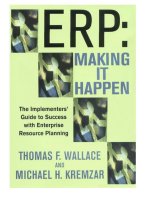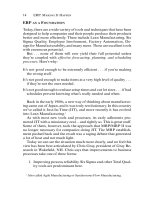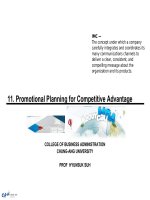promotional planning for competitive advantage
Bạn đang xem bản rút gọn của tài liệu. Xem và tải ngay bản đầy đủ của tài liệu tại đây (932.46 KB, 18 trang )
11. Promotional Planning for Competitive Advantage
IMC —
The concept under which a company carefully
integrates and coordinates its many
communications channels to deliver a clear,
consistent, and compelling message about
the organization and its products.
COLLEGE OF BUSINESS ADMINISTRATION
CHUNG-ANG UNIVERSITY
PROF HYUNSUK SUH
중앙대학교 경영
대학
2
What is “Promotion?”
Promotion
Promotion:
Communications by marketers that informs, persuades, and reminds
potential buyers of a product in order to influence their opinion or elicit a
response.
Promotional Strategy:
It is a plan for the optimal use of the promotional mix elements: advertising,
public relations, personal selling, and sales promotion.
McDaniel/ Lamb/ Hair, 2011, 2013
중앙대학교 경영
대학
3
What is “Competitive Advantage?”
Competitive Advantage
Strategic Competitive Advantage –
It is the set of unique features of a company and its products that are perceived
by the target market as significant and superior to the competition. Such
features can include high product quality, rapid delivery, low prices, excellent
service, or feature not offered by competition.
For exam ple, fast-food restaurant Subway promises
fresh san dwiches that are better for you than other
fast-food restaurants. Subway effectively
commun icates this “FRESHNESS” to its target
custome rs.
McDaniel/ Lamb/ Hair, 2011, 2013
중앙대학교 경영
대학
4
What is the role of promotion?
The Role of Promotion
중앙대학교 경영
대학
5
Then, what is “Marketing Communications?”
Definition: Marketing Communications
Marketing Communications:
The means by which firms attempt to inform, persuade, and remind customers,
directly or indirectly, about the products and brands they sell.
All marketing communications tool must be carefully integrated.
Kotler and Armstrong, 2010
Marketing Communications:
It is the process by which we exchange or share meanings through a common
set of symbols. Marketers communicate its selling message to potential
customers, they do it through various its promotional programs.
McDaniel/ Lamb/ Hair, 2011, 2013
중앙대학교 경영
대학
6
Marketing communications perform
many functions for customers.
Customers can be told or shown
how and why a product is used, by
what kind of person, where and
when; customers can learn about
who makes the product and what
company and brand stand for; and
customers can be given an
incentive or reward for trial or
usage. Marketing communications
allow companies to link their
brands to other people, places,
events, brands, experiences,
feelings and things.
Although ‘advertising’ is often a central element of a marketing communications
program, it is not the only one.
Marketing Communications Mix
1. Marketing Communications Mix
중앙대학교 경영
대학
7
The promotional tools from the previous page are explained below.
Major Promotional Tools
1. Marketing Communications Mix
Advertising is any paid
form of non-personal
presentation and
promotion of ideas,
goods, or services by an
identified sponsor
Broadcast
Internet
Outdoor
Sales promotion is the
short-term incentives to
encourage the purchase
or sale of a product or
service
Discounts
Coupons
Special events
Year-end sales
Public relations involves
building good relations with the
company’s various publics by
obtaining favorable publicity,
building up a good corporate
image, and handling or heading
off unfavorable rumors, stories,
and events
Press releases
Sponsorships
Web pages
중앙대학교 경영
대학
8
The promotional tools from the previous page are explained below.
Major Promotional Tools
1. Marketing Communications Mix-Advertising
Personal selling is the
personal presentation
by the firm’s sales force
for the purpose of
making sales and
building customer
relationships
Sales presentations
Trade shows
Incentive programs
Direct marketing involves making direct
connections with carefully targeted individual
consumers to both obtain an immediate response
and cultivate lasting customer relationships—
through the use of direct mail, telephone, e-mail,
and the Internet to communicate directly with
specific consumers
Telemarketing
Direct Mail
중앙대학교 경영
대학
9
The following is an example of the public relations of Chung-Ang University.
Magnitude of Advertising
United States:
United States:
$294 billion
$294 billion
($1,000 per person)
($1,000 per person)
Global:
Global:
$360 billion
$360 billion
Example
1. Marketing Communications Mix-Advertising
중앙대학교 경영
대학
10
To communicate effectively, marketers need to understand how communication works.
The communication process and its elements are described below.
•
Communications efforts should be viewed from the perspective of managing
customer relationships over time.
•
The communication process begins with an audit of all potential contacts a
customer might have with the brand.
•
Effective communication requires knowledge of how communication works.
Communication Process Model: MACROMODEL
The more the sender’s
field of experience
overlaps with that of
the receiver, the more
effective the message
would likely to be
2. Marketing Communications Process
중앙대학교 경영
대학
11
To communicate effectively, marketers need to understand how communication works.
The communication process and its elements are described below.
Sender is the party sending the message to another party
Encoding is the process of putting thought into symbolic form
Message is the set of symbols the sender transmit.
Media is the communications channels through which the message moves from
sender to receiver
Decoding is the process by which the receiver assigns meaning to the symbols
Receiver is the party receiving the message sent by another party
Response is the reaction of the receiver after being exposed to the message
Feedback is the part of the receiver’s response communicated back to the sender
Noise is the unplanned static or distortion during the communication process, which
results in the receiver’s getting a different message than the one the sender
sent
The Elements of Communication Process Model
2. Marketing Communications Process
중앙대학교 경영
대학
12
Marketers should understand the fundamental elements of effective communications :
MICROMODEL.
Consumer Response Models: MICROMODEL
3. Developing Effective Communications
중앙대학교 경영
대학
13
Remember in Chapter 6 where we’ve learned 4 different types of buying decision
behavior? Let’s review the concept with that of communication model.
3. Developing Effective Communications
Types of Buying Decision Behavior
L-F-D
L-D-F
L-D-(F)
(L)-D-F
중앙대학교 경영
대학
When putting the message together, the marketing communicator must decide what to
say (message content) and how to say it (message structure or format).
Design Message: Message Content and Structure
Message content is an appeal or theme that will produce the desired
response
It relates to the audience’s self-interest. They show the product
will produce the desired benefits. Examples are message
showing a product’s quality, economy, value, or performance.
RATIONAL
APPEALS
It attempts to stir up either negative or positive emotions that
can motivate purchase. Communicators may use positive
emotional appeals such as love, pride, joy, and humor
EMOTIONAL
APPEALS
It is directed to the audience’s sense of what is “right” and
“proper.”
MORAL
APPEALS
14
3. Developing Effective Communications
중앙대학교 경영
대학
15
The following ad appeals to which types of “appeals?” How would the rational ad for
this product talk about?
Design Message : Message Content
3. Developing Effective Communications
Example
중앙대학교 경영
대학
16
Design Message : Message Content
3. Developing Effective Communications
Example
The following two ads appeal to which types of “appeals?”
중앙대학교 경영
대학
17
Message Structure: Key decisions are required with respect to three
message structure issues:
1. Whether or not to draw a conclusion
2. Whether to put strongest arguments first or last
3. One-sided vs. two-sided argument
Message Format: Design, layout, copy, color, shape, movement, words,
sounds, voice, body language, dress, etc.
The message should get Attention, hold Interest, arouse Desire, and obtain Action
(AIDA model). The marketing communicator must decide what to say (content), and
how to say it (structure and format).
Design Message : Message Structure and Format
3. Developing Effective Communications
중앙대학교 경영
대학
18
Marketers can choose from two basic promotion mix strategies – Push or Pull.
Promotion Mix Strategies
3. Developing Effective Communications









